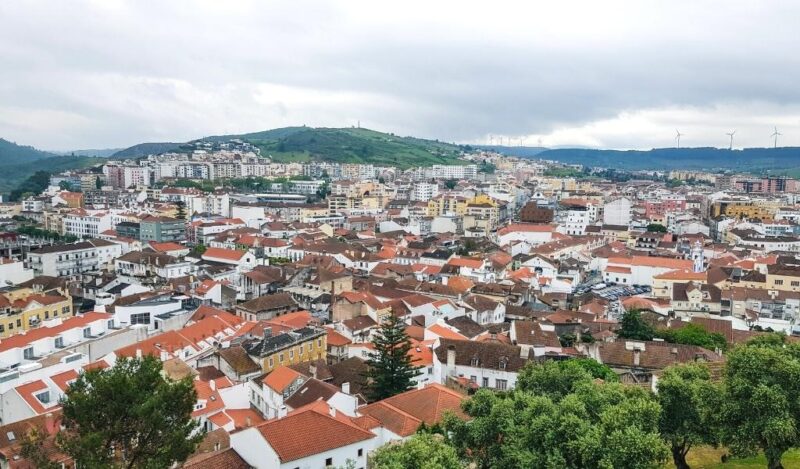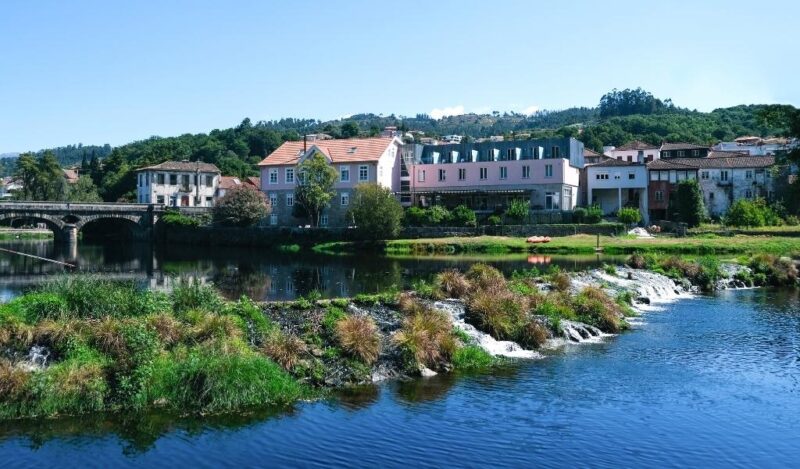Alcobaça is a city and municipality in the Leiria district, situated about 110 km from Lisbon. This means that this Alcobaça itinerary is the ideal choice for a day trip from the Portuguese capital, or even the perfect stopover on a multi-day road trip through the Oeste sub-region (in the Central Region)!
Despite not being as touristy and popular as Nazaré or Óbidos, Alcobaça has an impressive historical, artistic and cultural past. And, on this Alcobaça itinerary, you’ll have the opportunity to prove it in monuments such as the Monastery of Alcobaça, the Wine Museum of Acobaça, or the Alcobaça Castle!
So, do you want to know more about the 1 Day In Alcobaça: The Perfect Alcobaça Itinerary? Keep reading!
This post may contain affiliate links, meaning I earn a small commission if you make a purchase, at no additional cost to you. Please read my disclosure & privacy policy for more information.
No time to read now? Pin it for later!


Brief History of Alcobaça
The region where Alcobaça is today was inhabited by the Romans, Visigoths, and Arabs, before the arrival of the monks who founded the Monastery of Alcobaça. However, from the Middle Ages onwards, the history of Alcobaça is intertwined with that of its most important monument.
It all started in 1153 when King Afonso Henriques donated 40,000 hectares of border lands to Bernard of Clairvaux or Saint Bernard (the French abbot who reformed the Order of Cistercians). At that time, Portugal was a sovereign and independent kingdom for just a decade!


Motivated by the construction of the Monastery of Alcobaça, the population settled in this fertile valley between the Alcoa and Baça rivers. The territory was called Coutos de Alcobaça and reached an area of 440 km2, covering 14 towns and villages:
- Alcobaça – parish and seat of the homonymous municipality
- Alfeizerão – parish of the Alcobaça municipality
- Aljubarrota – parish of the Alcobaça municipality
- Alvorninha – parish of the Caldas da Rainha municipality
- Cela – parish of the Alcobaça municipality
- Cós – former parish of the Alcobaça municipality and seat of the current parish of Cós, Alpedriz e Montes
- Évora de Alcobaça – parish of the Alcobaça municipality
- Maiorga – parish of the Alcobaça municipality
- Paredes da Vitória – locality in the Pataias e Martingaça parish, in the Alcobaça municipality
- Pederneira – former parish and seat of the Nazaré municipality (which was called Pederneira until 1912)
- Salir de Matos – parish of the Caldas da Rainha municipality
- Santa Catarina – parish of the Caldas da Rainha municipality
- São Martinho do Porto – parish of the Alcobaça municipality
- Turquel – parish of the Alcobaça municipality
Visiting Alcobaça
In my opinion, the best way to visit the city of Alcobaça is on a day trip from Lisbon. And to get there from the Portuguese capital, you have two options: travel by car (about 110 km) or by public transportation (1h45-2h by bus).
However, Torres Vedras is also an excellent stop on a road trip through the Leiria district! In that case, I suggest you explore other destinations in the vicinity: Nazaré (15 km), Porto de Mós (19 km), Batalha (20 km), Caldas da Rainha (27 km), Marinha Grande (29 km), Leiria (32 km), or Óbidos (37 km).
Alcobaça Itinerary
Alcobaça Castle
This Alcobaça itinerary starts at the ruins of Alcobaça Castle (in Portuguese, Castelo de Alcobaça), the best panoramic viewpoint in the city.
Probably erected by the Moors, Alcobaça Castle was conquered by Afonso Henriques in 1147.
After that, the fortress was donated by King Sancho I to the Order of Cistercians, who rebuilt it in Romanesque and Gothic styles.
In the Middle Ages, Alcobaça Castle was part of Lisbon’s forward line of defense, along with Pombal Castle, Leiria Castle, and Óbidos Castle.

Monastery of Alcobaça
The next stop on this Alcobaça itinerary is the Monastery of Alcobaça (in Portuguese, Mosteiro de Alcobaça), which has been a UNESCO World Heritage Site since 1989. Formerly known as the Royal Monastery of Santa Maria de Alcobaça (in Portuguese, Real Mosteiro de Santa Maria de Alcobaça), it was the first major structure in Gothic architecture to be built in Portugal.

The Monastery of Alcobaça is open every day, from 9 am to 6 pm (from October to March) or from 9 am to 7 pm (from April to September). Tickets cost €6 (normal fare) or €3 (reduced rate for people over 65 and holders of a Student Card or Youth Card), while children up to 12 years old don’t pay admission. And the Church of Saint Mary of Alcobaça is free to enter!
Read my complete guide to the Monastery of Alcobaça, a must-see tourist attraction on any Torres Novas itinerary!
Republic Square
This Alcobaça itinerary continues in Republic Square (in Portuguese, Praça da República), one of the main squares in the city. Located a few meters from Afonso Henriques Square (the former barn of the Monastery of Alcobaça), it was once called Fish Square, Mulberries Square, and Prince Carlos Square.

As its original name implies, Republic Square once hosted a market (first for vegetables and fruits, and then for fish). Until 1992, it served as a car park – when it was converted into a pedestrian area, with café terraces, lawns, and garden benches.
The sculpture-fountain you see in the center of Republic Square is a monument to the monks!
Love Garden
The next stop on this Alcobaça itinerary is the Love Garden (in Portuguese, Jardim do Amor), one of the many places in the city that honor the love between King Pedro I and Queen Inês de Castro. By the way, be sure to visit their tombs in the Monastery of Alcobaça and the permanent outdoor exhibition “Pedro and Inês in Alcobaça’s Ceramics”, on the Pedestrian Walk.

Like any other public garden, the Love Garden is a space for leisure, socializing, and rest. And in addition to the privileged view of the Alcoa and Baça rivers, the great attractions here are the thrones of King Pedro I and Queen Inês de Castro, where many tourists sit to take pictures!
Church of Our Lady of the Assumption

This Alcobaça itinerary continues at the Church of Our Lady of the Assumption (in Portuguese, Igreja de Nossa Senhora da Conceição), a religious temple with austere architecture and decoration – although the chancel has a gilded altarpiece!
The Church of Our Lady of the Assumption dates from 1648, but the primitive chapel dates back to 1152. At that time, the construction works of the Monastery of Alcobaça were taking place, so the church served as a residence for the first monks.
The Church of Our Lady of the Assumption is open for visits from Monday to Friday, from 9:30 am to 6 pm. And entry is free!
Raul da Bernarda Museum
The next stop on this Alcobaça itinerary is the Raul da Bernarda Museum (in Portuguese, Museu Raul da Bernarda), a museum named after the oldest ceramics factory in Alcobaça. By the way, its collection is divided into two major exhibitions:
- “Ceramics Collection from Raul da Bernarda Factory” (permanent exhibition)
- “The Alcoa’s Folklore Group Costumes Alluding to the Ceramics of Alcobaça” (temporary exhibition)

The Raul da Bernarda Museum is open from Wednesday to Friday, from 10 am to 1 pm and from 2 pm to 5 pm; and on Saturdays, Sundays, and holidays, from 2 pm to 6 pm. And entry is free for everyone!
Wine Museum of Alcobaça
This Alcobaça itinerary continues at the Wine Museum of Alcobaça (in Portuguese, Museu do Vinho de Alcobaça), initially called the National Wine Museum. Considered the largest wine museum in Portugal in terms of architectural space and collections, it has more than 10,000 pieces on display!
As you can see from the name, this is a museum dedicated to the national wine and wine culture throughout the country. Inaugurated in 1986, it operated as a wine cellar before being a museum and was called Quinta dos Raposo de Magalhães since the end of the 19th century.

And did you know that this wine cellar had a capacity for 11 million liters of wine and brandy? In fact, the museum’s collection includes more than 7000 labels and 3000 bottles, ranging from the 19th century to 1996, when the owner donated the museum to the municipality.
The Wine Museum of Alcobaça is open from Tuesday to Sunday (including holidays) and requires a guided tour – which takes place every hour between 10 am and 5 pm. The ticket costs €4, but there are discounts for groups and admission is free for everyone on Sunday mornings!
Monks Park
This Alcobaça itinerary ends at Monks Park (in Portuguese, Parque dos Monges), a 24-hectare theme park located in the Quinta das Freiras, just over 3 km from the historic center of Alcobaça. Inspired by the history of the region and based on sustainability values, Monks Park comprises:
- Educational Farm – with specific attractions, such as the Converts’ Aviary, the Friars’ Chicken Coop, and the Mãe d’Água Aquarium
- Environmental Park – with 8 hectares of land and an area dedicated to native species
- Game Camp – with activities such as abseiling, archery, canoeing, climbing, hiking, orienteering, paintball, slide, traditional games, tree climbing, etc.
- Glamping Accommodation – with picturesque cottages dotted around the Nuns Lake
- Medieval Village – which recreates the life of the Cistercian monks when they arrived in Alcobaça
- Monk’s Shop – where typical products from the Alcobaça region are sold, such as wine, honey, jams, sour cherries, and clay tableware
- Nuns Lake – the “heart” of Monks Park

Map of the Alcobaça Itinerary
Share this blog post on your social media!
More Posts about Portugal
4 Best Monasteries In Portugal (That You Should Visit This Year)
5 Best Palaces In Sintra (That You Should Visit This Year)
1 Day In Penafiel: The Perfect Penafiel Itinerary
More Posts about Travel Itineraries
1 Day In Penafiel: The Perfect Penafiel Itinerary
1 Day In Torres Vedras: The Perfect Torres Vedras Itinerary
2 Days In Arcos De Valdevez: The Perfect Arcos De Valdevez Itinerary
What Photography Gear Do I Use?
- Camera Body: Fujifilm X-T4 Mirrorless
- Camera Lens: Fujinon XF 18-55 mm F2.8-4 R LM OIS
- Tripod: Manfrotto Compact Action
- Small Tripod: Manfrotto PIXI Mini
- Smartphone Adaptor: Manfrotto PIXI Clamp
- Memory Card: SanDisk 128GB Extreme PRO SDXC





